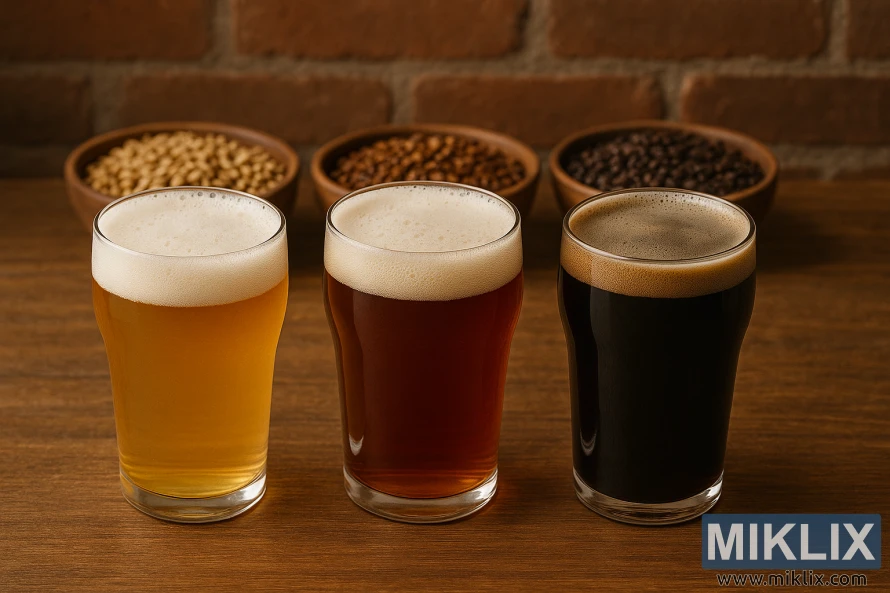Image: Three styles of homebrewed beer
Published: July 19, 2025 at 9:45:05 PM UTC
Last updated: September 27, 2025 at 12:51:42 PM UTC
Three tulip glasses of homebrewed beer—pale, amber, and dark—sit on rustic wood with bowls of malt, linking grain colors to beer shades.
Set against the timeless backdrop of a weathered red brick wall, this image captures the essence of artisanal brewing through a beautifully composed trio of homebrewed beers. Resting on a rustic wooden table, the three tulip-shaped pint glasses stand like sentinels of flavor, each one representing a distinct style and malt profile. Their elegant curves and polished clarity reflect the care and precision that went into crafting the brews they hold. The scene is steeped in warmth and character, evoking the quiet satisfaction of a brewer surveying their creations, each glass a testament to the transformative power of grain, water, yeast, and time.
The glass on the left contains a pale golden beer, its color reminiscent of sunlit straw or freshly harvested grain. A light, frothy head crowns the liquid, delicate and airy, suggesting a crisp and refreshing profile. This beer likely draws its character from lightly kilned malts—perhaps Pilsner or pale ale malt—offering subtle notes of biscuit, honey, and a gentle floral hop presence. Its clarity and brightness speak to a clean fermentation and careful conditioning, making it an ideal representation of lighter styles such as blonde ales or Kölsch.
In the center, the amber-hued beer glows with a deeper richness, its creamy foam sitting thick and inviting atop the liquid. The color hints at a more complex malt bill, likely incorporating medium crystal or caramel malts that lend sweetness, body, and a touch of roasted depth. The beer’s hue ranges from copper to burnt orange, catching the ambient light and revealing subtle gradients within the glass. This middle brew suggests a style like an amber ale or a red ale—balanced, malt-forward, and layered with flavors of toffee, toasted bread, and dried fruit. The foam’s density and persistence indicate a well-structured beer with good head retention, a sign of quality ingredients and technique.
On the right, the darkest of the trio commands attention with its near-black body and rich, tan head. The beer’s opacity and depth suggest the use of highly roasted malts—perhaps chocolate malt, black patent, or roasted barley—contributing flavors of espresso, dark chocolate, and charred wood. The head is thick and creamy, its color a warm contrast to the beer’s shadowy body. This stout or porter-style brew exudes intensity and comfort, the kind of beer meant to be savored slowly, its complexity unfolding with each sip. The glass itself seems to absorb the surrounding light, drawing the eye inward and inviting contemplation.
Behind each glass, wooden bowls filled with malted barley grains mirror the beers’ color progression. From pale tan to deep brown, the grains are neatly arranged, their textures and tones echoing the transformation they undergo during the brewing process. These visual cues link the raw ingredients to the final product, reinforcing the connection between malt selection and beer style. The grains’ natural beauty—smooth, cracked, glossy, or matte—adds a tactile dimension to the scene, grounding the viewer in the physicality of brewing.
The lighting throughout is soft and warm, casting gentle highlights on the glasses, the grains, and the wood. It enhances the richness of each beer’s color, the subtle sheen of the malt, and the inviting grain of the table. Shadows fall naturally, adding depth and intimacy to the composition. The overall atmosphere is one of quiet pride and thoughtful craftsmanship—a moment frozen in time where the brewer’s work is laid bare, ready to be appreciated not just for its taste, but for its artistry.
This image is more than a display of beverages—it’s a celebration of process, of the choices and care that shape each brew. It invites the viewer to explore the spectrum of beer, from light and refreshing to dark and contemplative, and to appreciate the humble grain that begins it all. It’s a portrait of brewing as both science and art, and a reminder that every glass holds a story worth telling.
The image is related to: Malt in Homebrewed Beer: Introduction for Beginners

